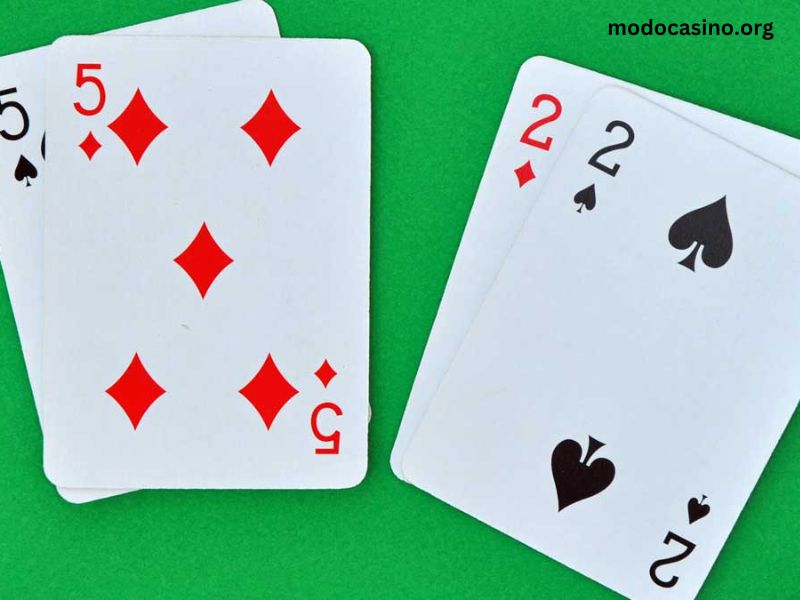Poker is one of the most popular card games in the world, known for its mix of skill, strategy, and chance. Within this game, the concept of “pocket pairs” is integral to the strategy of many poker variants, particularly Texas Hold’em. A pocket pair occurs when a player is dealt two cards of the same rank in the hole, which are the cards dealt face-down at the start of the game.
Understanding pocket pairs, especially the lowest pocket pairs, is crucial for anyone looking to improve their poker skills. In this article, we will take a deep dive into pocket pairs in general, focus on the lowest pocket pair, and explore the strategies associated with these hands.
What Is a Pocket Pair in Poker?
Before we delve into the specifics of the lowest pocket pair, it’s essential to understand what a pocket pair is. A pocket pair occurs when you receive two cards of the same rank as your hole cards. For example, if you’re dealt two Kings (K-K) or two Sevens (7-7), you’re holding a pocket pair.
Pocket pairs can be classified into three categories:
- Low Pocket Pairs: These are pairs between 2-2 and 6-6.
- Medium Pocket Pairs: These include pairs from 7-7 to 10-10.
- High Pocket Pairs: Pairs that are J-J or higher, including Aces (A-A), which is the highest pocket pair.
The Lowest Pocket Pair in Poker: Deuce-Deuce (2-2)
The lowest pocket pair in poker is Deuce-Deuce (2-2), also referred to as “ducks.” This pair is the weakest in terms of rank, as 2 is the lowest number on a standard deck of cards. While holding pocket deuces may not seem impressive at first glance, the hand has the potential to become a winning one under the right circumstances.
Let’s break down the characteristics, strengths, and weaknesses of pocket deuces, as well as strategies for playing them effectively.
Why Are Pocket Deuces Considered Weak?
Pocket deuces, like all low pocket pairs, are considered weak for several reasons:
- Low Rank: The number 2 is the lowest-ranked card in poker, which means that if your pocket pair doesn’t improve by hitting another 2 on the board (forming a set), it will likely be beaten by higher-ranked pairs or stronger hands like straights, flushes, or higher two-pair combinations.
- Vulnerability to Overcards: One of the significant challenges with pocket deuces is that almost every card on the board will be an “overcard.” An overcard is any card higher than your pocket pair, meaning in most flops, turns, or rivers, there will likely be at least one card that can form a higher pair than your deuces.
- Limited Post-Flop Strength: If you don’t hit a set (three of a kind) on the flop, it becomes incredibly challenging to continue playing pocket deuces effectively. The hand’s limited value post-flop means you will often be playing a guessing game to see if your opponent has a better pair.
The Power of Pocket Deuces: Set Mining
Despite their weaknesses, pocket deuces hold one key strength that can turn them into a monster hand: the ability to hit a set. A set occurs when one of the community cards matches your pocket pair, giving you three of a kind. This can dramatically increase the value of your hand, and set mining is a popular strategy employed by poker players with low pocket pairs like deuces.
What Is Set Mining?
Set mining is a term used in poker to describe the strategy of playing small pocket pairs with the primary goal of hitting a set on the flop. If successful, this can give you a concealed and potentially very powerful hand.
- Implied Odds: The implied odds of set mining with pocket deuces can be favorable. Implied odds refer to the potential to win a large pot if you hit your set. Players often don’t expect you to have a set of low cards, which can help you extract more chips from opponents who believe they have the best hand.
- Hitting a Set: The odds of hitting a set on the flop are approximately 7.5:1, or around 12%. While this means you’ll only hit a set about one in eight times, the potential payout when you do can make set mining profitable in the long run.
- When to Set Mine: Set mining with pocket deuces is generally most effective in situations where there are deep stacks and multiple players in the pot. The reason is that if you hit your set, you’re more likely to win a large pot, making the risk of calling pre-flop worthwhile.
Pre-Flop Strategy with Pocket Deuces
The way you play pocket deuces pre-flop can set the tone for the rest of the hand. While pocket deuces are weak compared to higher pairs, they still have value and can be profitable if played correctly.
Early Position
Playing pocket deuces from an early position (first to act) is tricky. Since you’ll likely face raises or calls from players behind you, it’s often best to fold pocket deuces from early positions unless you’re in a deep-stacked tournament or cash game where set mining is viable.
Middle Position
In middle position, pocket deuces become a bit more playable. If the table is passive, you can consider limping in (calling the big blind) to see a cheap flop. However, be prepared to fold if there’s significant raising behind you. If you’re in a more aggressive game, raising with pocket deuces can be risky, as it’s hard to continue without improvement on the flop.
Late Position
In late position, pocket deuces are much more playable. If no one has raised, you can try to steal the blinds with a raise. If someone has raised, you can call if the raise is small, and the stacks are deep enough to justify set mining.
Post-Flop Strategy with Pocket Deuces
Once the flop comes, your strategy with pocket deuces will heavily depend on the texture of the board.
Flopping a Set
If you hit your set on the flop, you’re in an excellent position to win a large pot. With a set of deuces, it’s often a good idea to play deceptively, either by slow-playing (checking or calling instead of betting aggressively) to trap opponents or by betting small to build the pot.
Keep in mind that certain flops, such as three cards of the same suit or a coordinated board (e.g., 4-5-6), can be dangerous, even with a set. In these cases, you should play more cautiously to avoid losing to a straight or flush.
Missing the Flop
If you don’t hit a set, pocket deuces become much less valuable. If the flop contains overcards (which is very likely), you’ll need to consider your opponent’s actions and the texture of the board. In most cases, it’s best to fold if you’re facing bets, as continuing with pocket deuces without improvement can be costly.
If the flop comes with low cards and no obvious draws, you may consider a continuation bet if you were the pre-flop aggressor, but only if you believe your opponents may fold.
Pocket Deuces in Tournament Play
In poker tournaments, pocket deuces can be both a blessing and a curse. Early in a tournament, when stacks are deep, set mining with pocket deuces can be a solid strategy. However, as the tournament progresses and blinds increase, playing pocket deuces becomes more challenging due to the shrinking stack sizes.
In late-stage tournament play, pocket deuces often turn into a shove-or-fold hand. If you’re short-stacked, you may need to push all-in with pocket deuces, hoping to win the blinds or win a race against overcards like A-K or K-Q.
Conclusion
The lowest pocket pair in poker, deuces (2-2), may seem like a weak hand, but it has hidden potential when played correctly. The key to success with pocket deuces lies in set mining, understanding when to fold, and knowing when to push your advantage after hitting a set. While pocket deuces are vulnerable to overcards and often require careful play, they can result in big wins under the right circumstances. Mastering the strategy behind low pocket pairs like deuces will help you improve your overall poker game and give you an edge at the table.



